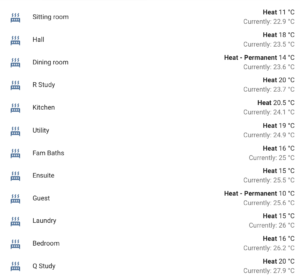Rose and I are still playing low-tech Wordle from time to time. She came rather close to defeating me yesterday: her word was ‘Hydra’. Very slippery. Took me quite a while to kill that one.
Author Archives: qsf
How to deal with criticism
Esther Bintliff has a splendid (longish) piece in the FT entitled, “Feedback required: the science of criticism that actually works“. She begins:
Years ago, after I received some negative feedback at work, my husband Laurence told me something that stuck with me: when we receive criticism, we go through three stages. The first, he said, with apologies for the language, is, “”Fuck you.”” The second is “”I suck.”” And the third is “”Let’s make it better.”” I recognised immediately that this is true, and that I was stuck at stage two.
These three stages seem to be somewhat universal, and many people, she points out, never even make it as far as stage two, and get hung up at the angry response. But you can only benefit from feedback if you get through both of those stages to the third.
Depending on your personality, you may be more likely to stay at stage one, confident in your excellence and cursing the idiocy of your critics. The problem, Laurence continued, is being unable to move on to stage three, the only productive stage.
Now, this is simple, memorable, and worthy of regular contemplation, and the article would have been useful if it stopped there. But no, there’s plenty more good stuff to come.
How, for example, should you ask for feedback if you actually want people to give it to you?
How might your feedback be presented in a way that helps others to get to stage three?
How is this connected to The West Wing?
And how often is any sort of feedback actually worthwhile? What about those regular performance reviews that so many businesses undertake? She talks about when Avraham Kluger met Angelo DeNisi, both researchers in this area..
When Kluger told him he was studying the destructive effects of feedback on performance, DeNisi was intrigued. “”My career is based on performance appraisal and finding ways to make it more accurate. You’re telling me the assumptions are incorrect?”” he asked. “”Yes, I’m afraid I am,”” replied Kluger.
The two reviewed hundreds of feedback experiments going back to 1905. What they found was explosive. In 38 per cent of cases, feedback not only did not improve performance, it actively made it worse. Even positive feedback could backfire. “”This was heresy,”” DeNisi recalls.
I think this is another example of very enjoyable and informative journalism from the FT, but it is behind their paywall, so I shouldn’t reproduce too much of it here.
Too financial for our times?
The problem with the FT is that it is really quite expensive as online publications go. £1 or so per day does add up over the year, and makes it more expensive, for example, than Netflix, Spotify and Disney+ combined. Bizarrely, you can have them deliver a paper version through your door each day for somewhat less than even their basic digital access package.
If, however, you are rather wealthy, or, like me, you’re fortunate enough to be associated with an organisation that pays for FT access, then I would suggest it’s a perk well-worth exploring. (The iPad app is also good, and lives on my home screen.)
If not, I guess you can keep an eye on the headlines and pop to the newsagent if you see something that piques your interest. Remember newsagents? I guess they’re not just for cans of San Pellegrino — they’re a useful alternative to bits of the internet that are too expensive.
In the meantime, I have a small number of gift links I can use to give non-subscribers access to the article, so get in touch if you’d really like to read the rest of it.
There! That should get me some nice feedback.
Home Automation for Heat Waves
 As we face record high temperatures in the UK today and tomorrow, it seems likely that climate change may bring us more of these in the future, so my first job over breakfast today was to write a little script for my Home Assistant-based home control system that sets all the blinds on the east- and south-facing windows to be 70% closed. We’ve never used them before to keep sunlight out in the middle of the day, but they work rather well.
As we face record high temperatures in the UK today and tomorrow, it seems likely that climate change may bring us more of these in the future, so my first job over breakfast today was to write a little script for my Home Assistant-based home control system that sets all the blinds on the east- and south-facing windows to be 70% closed. We’ve never used them before to keep sunlight out in the middle of the day, but they work rather well.
A bit later, as temperatures in my upstairs study were still getting rather high, I started to think about the radiators. Why? Well, we have smart thermostatic valves on all of them, which report back the temperature in each room. Normally, of course, this is so that each room can be heated to the right level for the time of day. (I have a separate schedule for each room, which is modified automatically based on things like whether there are guests in the guest room, or whether Rose’s phone is detected in her office in town rather than her study at home, or whether we’re watching TV in the evening.)
But I hadn’t really thought of making use of this data in the summer, until today, when I realised I could easily sort all my rooms in order of increasing temperature. A quick new view added to my control panel showed that yes, indeed, my study was currently the warmest room in the house, and the sitting room was the coolest:
So it would be much more sensible to go and work from the comfort of the sofa, rather than from my desk.
As a result, this comes to you from the sitting room, and I have successfully improved my comfort level. As you can tell, though, I don’t think it actually resulted in me doing more work…
Re-branding question for the day…
I’ve been wondering… When did a ‘rug’ or ‘blanket’ or ‘bedspread’ become a ‘throw’?
From the John Lewis website: this is a throw:
And this is a bedspread:
Was it when British heating and insulation reached the point when you no longer needed blankets to wrap around humans, and so they just had a decorative role?
I suspect this coincided with a trend towards plainer, less-patterned furniture, and so you needed something to add a splash of contrasting colour.
And why ‘throw’, anyway? When do you throw ’em and when do you spread ’em? Is it a marketing ploy by manufacturers to encourage you to use on sofas those product that you might previously have reserved for picnics or chilly bedrooms, but in either case would probably just have involved spreading?
Anyway, I suspect ‘throw’ to be something of an aspirational statement: the idea that you casually cast these things around, but the combination of your good aim and your good taste means that they’ll make your home look like something out of Country Life.
My next line of fashionable home decor accessories will include the ‘Quilted Scrumple’ and the ‘100% Highland Wool Chuck’, for those whose tastes tend to the even more casual. Only this with a really good eye and throwing arm, though, will be able to get the best out of my ‘Chenille Hurl-across-the-room’.
In touch with the tech…
My friend Pilgrim Beart publishes a monthly email newsletter covering topics from IoT, electric vehicles, clean and smart energy.
I like the format: generally just a list of one-sentence bullet points with links to relevant articles elsewhere. Very easy to skim and find items of interest. You can see back issues here to give you an idea, and sign up here to have it in your inbox each month.
Amongst the many things I learned over breakfast today:
In the UK, electric vehicles are now estimated to have one-third of the carbon footprint of their combustion-powered equivalents over their lifetime. (This is partly because of the ever-greener UK power network, one of the few recent national achievements we can be proud of at present!)
There’s a new Raspberry Pi designed for embedding in things: the Pico W. It addresses the issue I’ve always had with devices like the Arduino and the earlier Pico: no built-in network connectivity. For me, devices are usually only interesting if they’re networked, and much of my home automation depends on devices containing the wifi-enabled ESP8266 and ESP32 devices – smart plugs & relays, energy monitors etc. At $6, the Pi team are clearly aiming at this market with the new device. They’ll need to enable its Bluetooth capabilities soon, though, if they want people to build devices supporting the new Matter protocols, which I think has a good chance of being a very important cross-vendor standard in the near future.
Bloomberg predicts that VW’s EV sales will overtake Tesla’s in 18 months’ time. This can only be a good thing. Much as I love my Tesla, I’ve also been a big fan of VW for decades, and am delighted to see them reborn, Gandalf-like, in whiter raiment than they had before. They (and all car manufacturers) do need major work on their software, though: when I tried the ID-3 a couple of years ago, I found significant bugs even in my 15-min test-drive. Perhaps it has improved since then. If they don’t get a good handle on this, a lot of manufacturers are going to have to buy their software from Apple. I have to say that a VW with Apple software is something I would find very tempting…
Word Play
This is a really useful site, which I’ve somehow missed before now:
Are you wandering through an art gallery, and become fearful that your new date will laugh at you if you mispronounce trompe-l’oeil? Never fear! Just pop to the loo with your phone for a moment, and Forvo will let you find and listen to a number of native French speakers saying exactly that phrase. You can then return confident and ready to impress!
Passing through Scotland, and want to ask the way to Culzean or Glen Garioch without the locals sniggering at you?
It will do translations too. If you need to call for a helicopter to lift you off a German mountain, Forvo will both tell you the word, and how to say it.
The great thing about this is that it isn’t an automated voice; these are real people speaking, and you can often compare the same word being spoken by people from different regions. If you’re already familiar with it, you can vote on who pronounces it best, and if you think everybody has got it wrong, you can contribute a recording yourself.
BellÃsimo! (as they say in Mexico)
Happy feet
I hope it makes you smile too!
Want to know how cameras and lenses work?
This is an amazing page by Bartosz Ciechanowski: a tutorial where you can drag things, rotate things and generally be interactive while learning how cameras work.
A great deal of labour must have gone into this, and it’s also a very impressive demo of what web browsers are capable of these days.
But if cameras aren’t your thing, don’t worry – Ciechanowski doesn’t stop there.
How about watches? Or internal combustion engines? Or…
Well, you get the idea! Pretty impressive stuff.
Thanks to Michael Dales for the initial link.
Signalling virtue
Dear Reader,
Can I encourage you to try something today? Go to Signal.org and get hold of the Signal messaging app, and/or go to your app store and download Signal for your phone. And while it’s downloading, come back here and I’ll tell you why I’ve become so fond of it, and why you might actually want another messaging app.
To put it in a nutshell, Signal is like WhatsApp but without selling your soul. Imagine what a good time Faust would have had without that awkward business with the Devil, and you get the idea. Well, OK… you don’t quite have to sell your soul to Facebook to use WhatsApp, but you do have give away your privacy, your friends’ privacy, endure a lot of advertising, and so forth. (More info in an earlier post.)
For Apple users, Signal is rather like Messages, which I also like and use a lot, but you can use Signal with your non-Apple friends too, on all of your, and all of their, devices.
Signal:
- is well-designed and nice to use.
- runs on iOS, Android, Windows, Mac, Linux, tablets, desktop and mobile.
- uses proper end-to-end encrypted communications, unlike some alternatives such as Telegram.
- is Open Source, so if you doubt any aspect of it, you can go and see how it works.
- is free: supported by grants and donations. No advertisements.
- allows most of the interactions you expect on a modern messaging service: group chats, sharing files and images, audio and video chat, etc.
Now, of course, it has the problem that all networks initially have: what happens if none of my friends are on it? And yes, that can be an issue, but it’s becoming less so. When I first signed up, I think I knew about three other users. Now, over 100 of my contacts are there, and more arrive every week. When I see them pop up, I send them a quick hello message just to welcome them and let them know I’m here too. It’s a bit like wondering if you’re at the wrong party because you know so few people here, and then over time more and more of your friends walk through the door.
How do you find them? Well, like WhatsApp, Signal works on phone numbers, and when you sign up you have the option to let it scan your contacts list and see if any of them are on Signal too. Unlike Facebook/WhatsApp, however, your contacts’ details aren’t transmitted to the company’s servers and used to build the kind of personal profiles that FB keeps even on people who aren’t members.
Signal instead encrypts (hashes) the phone numbers in your contacts, truncates the encrypted form so it can’t be used to match the full phone number, sends those truncated versions to their servers, and if it finds matches for any truncated other account numbers it sends the encrypted possible matches back to you for your app to check. Security experts will realise that this isn’t perfect either, but it’s so much better than most of the alternatives that you can be much more comfortable doing it. Here’s a page talking about it with a link to more detailed technical descriptions about how they’re trying to make it even more secure. And here’s the source code for all their software in case you don’t trust what they say and want to check it out for yourself.
So in recent months, if I’ve wanted to set up group chat sessions to discuss the care of an elderly relative, or plan a boating holiday with friends, or discuss software development with colleagues in another timezone, I tell people that I disconnected from Facebook a few years back so I don’t do WhatsApp, but have you tried Signal? It’s pretty much the same, with all the bad bits taken out, and works much better on the desktop and on tablets, in my now-rather-dated experience, than WhatsApp ever did.
So give it a try, and if you find that not many friends are there, don’t delete it. Just wait a bit… and tell all your friends about this post, of course!
Encloak Demo
For those interested in the Encloak Hide device that I mentioned a few days ago, you can now see a demo of how it works:
I should perhaps emphasise that this is the basic version; the Encloak Connect and Encloak Pro versions in the pipeline will do rather more.
Just for the avoidance of doubt: I have no commercial relationship with the company; they’re just old friends whose work I respect.
Brunch with Brent
Amongst the tech podcasts I enjoy while driving, dog-walking, etc are the ones from Jupiter Broadcasting.
The Self-Hosted show, in particular, discusses topic and news of interest to those who like to run some of their own IT infrastructure rather than outsourcing it all to third parties. It covers areas like backups, VPNs, media servers, and home automation (one of my current hobbies)!
Linux Unplugged keeps me in touch with Linux news. Even though I’ve been a heavy user of Linux since the days when it was first released as two floppy disk images, and I run and manage a large number of Linux servers, both personally and professionally, I haven’t really used it as my desktop operating system since Apple’s release of MacOS X gave me a Unix-based alternative, so this helps keep me in touch with developments there as well as on the back-end.
Anyway, I recommend these if you’re interested in such geeky topics; I think they’re nicely produced.
And then there’s Jupiter Extras, a feed with a range of interviews and other stuff that doesn’t really fit into any of the other streams. One of the Jupiter hosts, Brent Gervais, has a set of periodic interviews labelled ‘Brunch with Brent’, and I was delighted to be invited to join him for one of these a little while ago (published yesterday), in which he let me ramble on about everything from scuba diving to the patent system, from QWERTY keyboards to self-driving cars.
The full discussion can be found on Episode 86, and there’s a shorter extract in the middle of the latest Linux Unplugged episode too.
Playing fast and loose…
Subjects like the Northern Ireland Protocol, and Boris Johnson’s plans to disregard the bits he find awkward, are not the kind of thing I’d normally cover in this blog.
But a good friend, Prof. Mark Elliott, has just made a nice video explaining the situation on the University’s YouTube channel. Worth 9 minutes of your time if you want to avoid the banter and bluster from other sources.
© Copyright Quentin Stafford-Fraser






Recent Comments